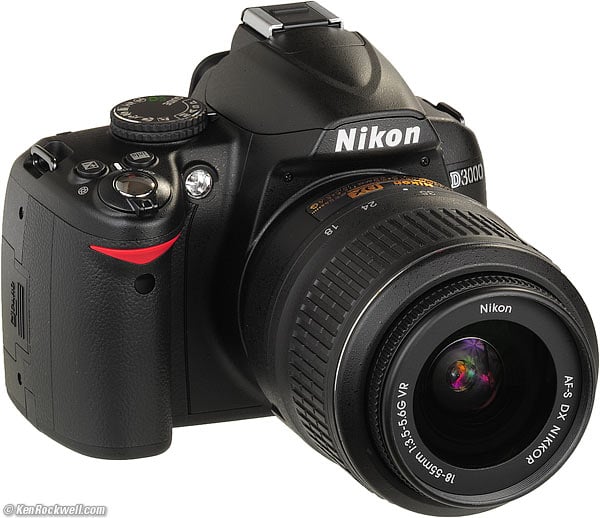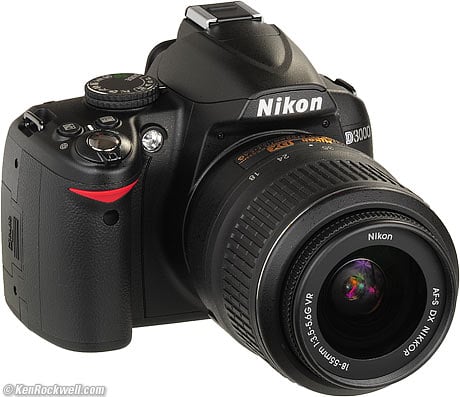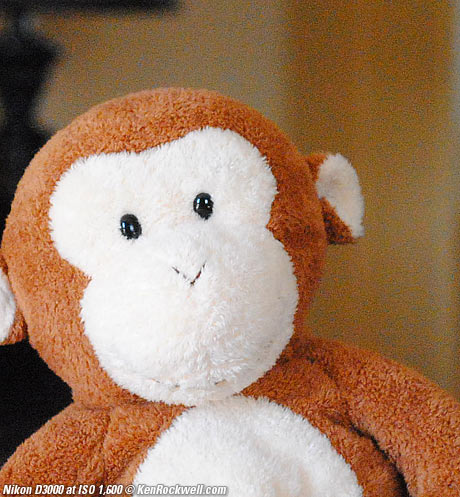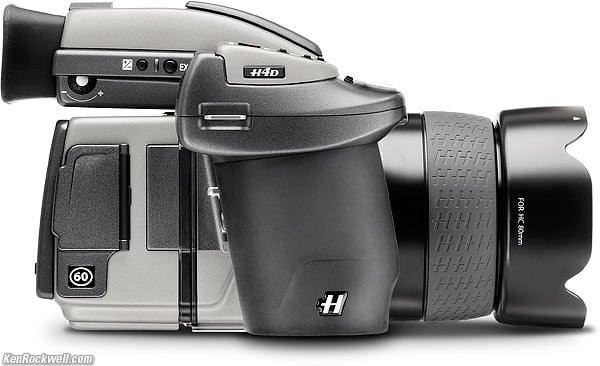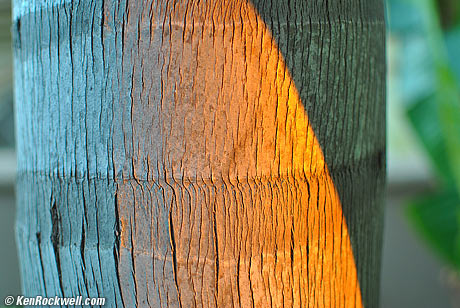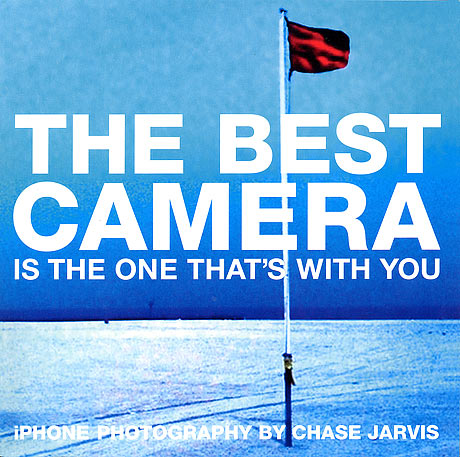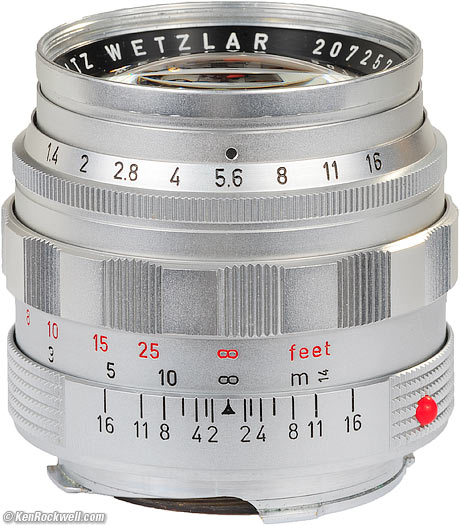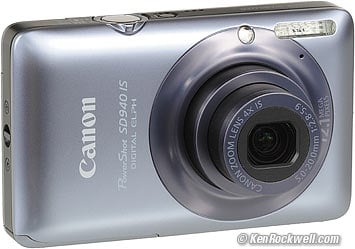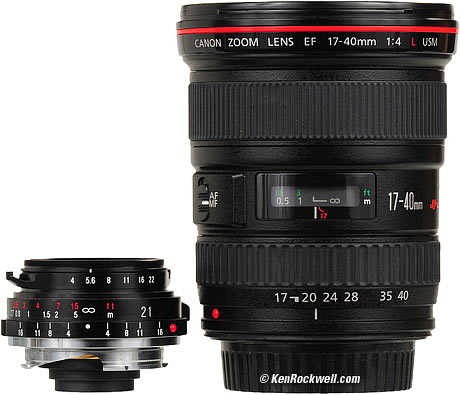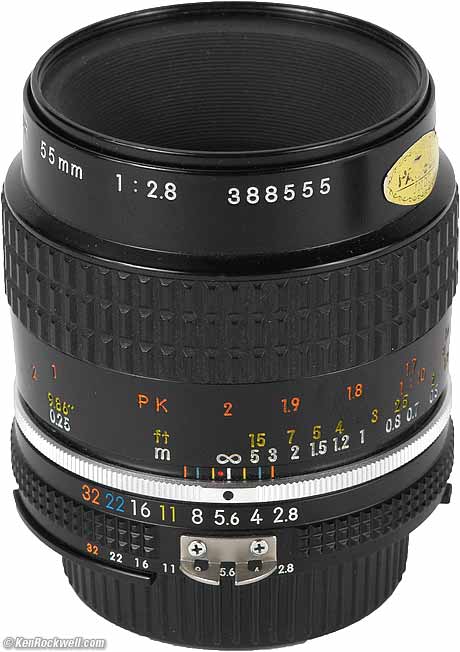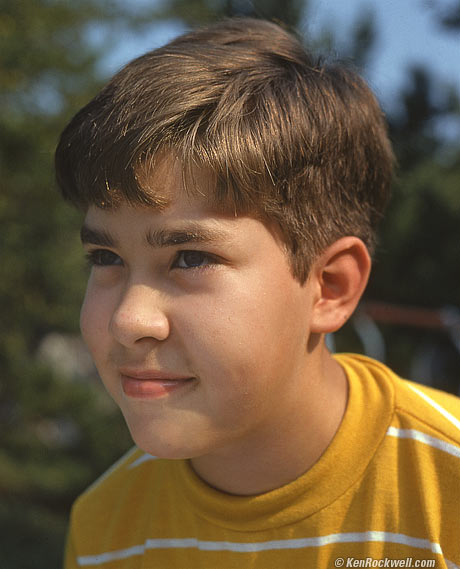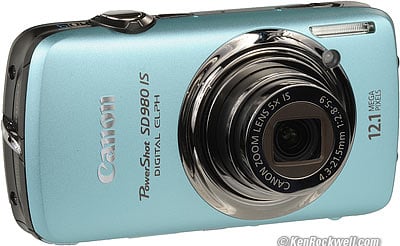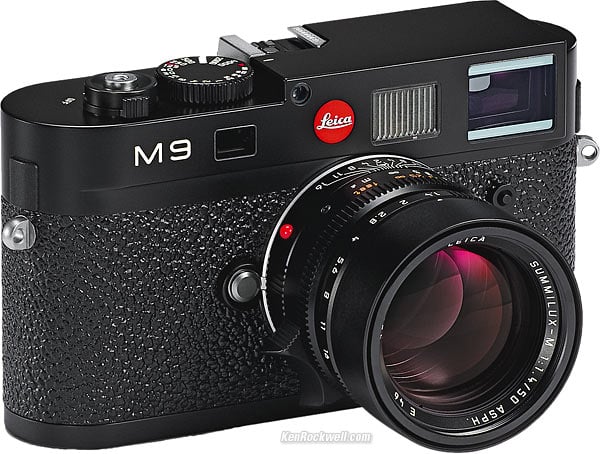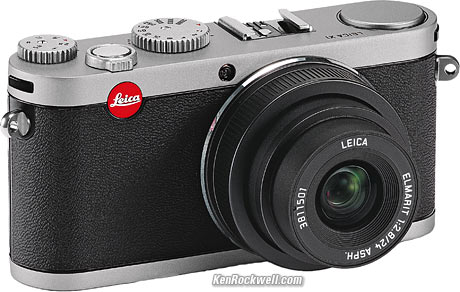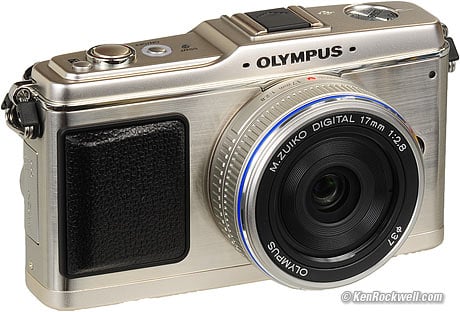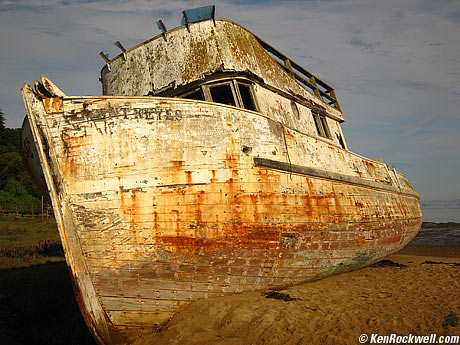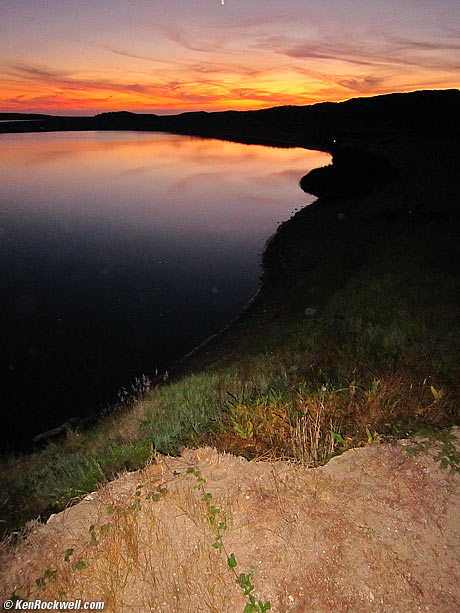Home Donate Search Gallery How-To Books Links Workshops About Contact
September 2009's Updates
RSS: live daily
all © 2009 KenRockwell.com. All rights
reserved.
|
I personally buy from Adorama, Amazon, Ritz, B&H, Calumet and J&R. I can't vouch for ads below.
|
30 September 2009, Wednesday
Made in New York!
For the past 130 years, New York has always been pretty important in photography. Both for exposition, and especially for equipment, New York is the place.
Since the 1970s we've all known that Adorama and B&H Photo Video in New York City are the world's biggest and best sources for everything photographic, and we also know that Rochester, New York has been the place where George Eastman lived since he was 5 years old, invented dry plates and then invented film, and where Kodak has been making those plates and film since the 1880s. Eastman has been cranking this stuff out of Rochester for one-hundred and thirty years!
Most of us went to Fuji Velvia or other films in 1990, but Kodak has been busy off in the commercial and other fields.
Now we all hear that the LEICA M9 has a Kodak sensor.
Hmm. I picked up the phone and called Kodak.
Lo and behold, the LEICA M9's CCD really was designed expressly for Leica.
The M9's CCD is manufactured in Rochester, New York, and is very much made in USA. It's made in the same building where it and other Kodak CCDs are designed and manufactured.
Good golly, the hottest thing in photographic capture today again comes from Rochester! Saints alive!
Of course the M9 is expensive. It's a professional product, and uses the best parts it can. Consumer products like Nikon and Canon are designed worrying mostly about cost, with performance second.
Do you know where else you find Kodak CCDs? They are all over military and space systems, where performance is critical, and cost is largely irrelevant.
Have you seen the recent photos of the original Apollo ships on the lunar surface made by NASA's Lunar Recognizance Orbiter (LRO), currently orbiting the moon and which just discovered water on the moon? The LRO uses a Kodak CCD for those photos.
Venus? There's another Kodak CCD orbiting and sending back images.
Mars? There are three cameras flying around armed with Kodak CCDs.
Sure, if you want to build a $5 webcam, look elsewhere, but if you want the best sensors you can get, get a Kodak CCD. Kodak also makes the 50MP sensor in the new Hasselblad H4D, so there.
GO USA!!!!
Nikon D3000.
NEW: Nikon D3000 Users Guide.
NEW: Nikon D3000 AF System Users Guide.
The D3000 may not work that well,compared to other Nikons, but the good news is that Nikon redid the menu system and it makes much more sense for the first time in a long time.
For instance, all the things related to shooting are in the SHOOTING MENU, and the custom function menu is no more. Thank goodness! I hate custom functions. I'm sure I'm not the only one who hates having to look in three different menus to find what I need.
This made it a heck of a lot easier for me to write this users guide, too.
29 September 2009, Tuesday
Nikon D700X on-target: I just reviewed my Nikon DSLR history, and noted that Nikon waited 15 months, not 12, to introduce the D3X after the D3 (01 December 2008 from 23 August 2007).
Since the D700 was announced on 01 July 2008, that puts the D700X right on target for announcement any time from now through Christmas this year. Nikon will probably have to do it, in the wake of all the people dropping their old D700s in the bins at Goodwill when stepping up to the LEICA M9.
Honestly, though, the M9 is a completely different kind of camera from an SLR. Neither replaces the other.
Nikon D3000.
NEW: Nikon D3000 Review.
Now that I've had my hands on one for a while, the more I use it, the more ways it's finally dawned on me that the D3000 is Nikon's worst DSLR ever!
The D40 is significantly better, and for less money. Get them while you still can, because if you don't get a D40, the D5000 will be the least expensive decent Nikon DSLR.
I'm almost offended by the D3000. I do this site for fun. I go off on tangents because I can. I talk a lot about Nikon, Canon and Leica because they all make great stuff. No one pays me anything to write all this.
When Nikon makes whatever stupid mistakes they made inside the D3000 to make it run so slow, I'm offended since I'm spending good time that I should be out playing with my kids or going for a bike ride instead of writing about how bad it is.
Nikon D3000 at ISO 1,600.
NEW: Nikon D3000 High ISO Comparison.
I've gotten so used to all DSLRs with the same sized sensor being so similar that it surprised me when the D3000 turned out so bad.
The Nikon D3000 is the worst DSLR I've ever used at high ISOs. The D40 gives the same results at one-stop higher ISOs, and the D40 isn't exactly the king here either! The D90 is even better than the D40 or D300 as I've shown before.
Nikon 14-24mm on the Canon 5D Mark II?
Everyone asks, and I wouldn't bother with this kludge.
What some hackers do is use a special adapter to use the superior Nikon 14-24mm AF-S on their 5D Mark II or other Canons. They do this because Canon has no lenses with the level of performance of the Nikon 14-24mm, which is in a class by itself.
The downsides are that you now have totally manual everything on the Canon. You have no idea how manual it gets; you even have to stop down the diaphragm manually for each shot ad open it afterwards!
On my 5D Mark II, I prefer my Canon 16-35 II and 17-40L. I love them.
For real photography, creativity in shooting freely and getting the camera wherever and whenever it needs to go is far more important than getting every last pixel sharp.
If I jacked myself with a manual adapter on my Canon, I'd be missing shots screwing with manual settings on an adapted lens. Missing shots are a lot worse than missing a pixel here and there.
As we soon shall see, an M9 is a much better solution for quality, and a lot easier and lighter, too.
Hasselblad H4D.
NEW: Hasselblad H4D: 60MP
Since the Leica M9 bridges the quality gap between 35mm full-frame DSLRs and medium-format digital systems, Hasselblad saw the need to pull medium-format cameras up another notch.
With the lightweight and compact M9 giving just about the same quality that used to require lugging a medium format DSLR around, and with the not-quite yet available medium-format Leica S2 SLR coming out at a very reasonable price (for serious pros), Hasselblad couldn't just sit on their accomplishments.
You've got to love competition.
28 September 2009, Monday
Colors of the D3000
Last Light, last night. enlarge.
I snapped this with the D3000 and 35mm f/1.8 last night. The orange in the middle is from the sun, the cyan on the left is from the sky, and the green is from the plants.
Sneak preview: for those who are waiting, I'm rounding up my experiences, but it looks like I'm going to suggest the D40 as the superior camera, at a lower price.
25 September 2009, Friday
Gear has very little to do with photography
And so says Chase Jarvis in his latest art book, shot (and processed) entirely on his iPhone.
Chase's new art book.
To quote again from his book, "The gear you can't afford is not the barrier keeping you from success."
I don't know how many pros need to tell everyone, but your camera has nothing to do with your pictures, and even better, the simpler your camera, they better the pictures you'll take with it!
I'm done with cameras that are too complex. I don't know how many workshops I have to teach where we never get away from discussing meaningless things like camera menus and file formats, and never get to starting to talk about anything that really matters in photography, which is light, color and composition.
Chase's book is brilliant. It's full of hundreds of great shots. I just got my own copy, and it's going to sit on top of my pile of art and photo books from now on. I'm also gong to bring it on my workshops and pass it around so all the guys with the fancy cameras might sit back and have a big "hmmm" as they contemplate the silliness of whatever new piece of gear they thought was their bridge to get from where they are today to making great pictures.
Hint: It's never the gear. It's always you.
Randomania all over again!
Litle kid that I am, I love the Random Page link written for me by David Rekowski.
Even funnier is that in the Top Sites view in Safari 4, it shows the last page I called with that link, but when I click on it again in Top Sites in Safari 4, it brings me to another random page. Hee hee!
LEICA SUMMILUX 50mm f/1.4.
NEW: LEICA SUMMILUX 50mm f/1.4 Review. Leica's top lens for over 40 years.
Canon S90 at Amazon: Amazon is taking orders for the S90 again. Adorama never stopped.
22 September 2009, Tuesday
Gotta-Have-It Report
Adorama has already shipped their first LEICA M9 to a lucky customer.
The bad news is that the M9 is a hand-made precision instrument, and you can't hurry excellence. Leica isn't cranking them out with robots in China like everyone else these days. That means that it may be December or January before the people who waited a few days to order theirs get them. Leica is crafting them as fast as excellence permits.
No one has seen a production Canon S90 yet. I played with a prototype last month, but the Canon elves still haven't cranked out a container load yet.
Who hates their customers more?
Some companies seem to hate us.
Some companies do their best to hide from us and have as little contact with us as possible, other than when taking our money.
Try to get these people on the phone, try to meet with one of their employees or get a problem resolved, and good luck. They are too worried about themselves to worry about a customer. We're pests.
Other companies like Canon, Leica, Mercedes-Benz ((800) FOR-MERC), Costco and Apple (your local Apple Store) seem to enjoy our business, do things in our long-term best interests, and make themselves available to us whenever we need them.
The bad companies try to get us sucked in with predatory contracts or devious technical issues in such a way that we can't replace them with a better product, even if we'd love to, while good companies try to keep us by giving us such great service and support that we wouldn't possibly want to leave.
It all comes down to companies who go out of their way to do the right thing for the customers, and those who are more concerned about quarterly returns to shareholders and their own employees. Are they concerned more about us, or themselves? That is the question.
I wonder who hates their customers more? Beats me. It just seems that some companies love to hear from us, while others do their best to barricade themselves from us, the annoying customers.
GM (Let's take out ads telling everyone how great we are now, instead of making cars people love. Actually, I don't think GM hates us that much, I just don't think we've been their first priority for some time.)
Dell (want tech support? It took my wife three months! That's hatred.)
Nikon (Good luck contacting anyone other than (800) NIKON-UX, who are excellent, and Nikon does make great stuff.)
AT&T (Want out of your contract? Fat chance! All AT&T cares about is ARPU.)
Microsoft (Viruses? Need an upgrade? Don't get me started. You should never need to have to pay someone (or be that computer whiz) to keep your computer running perfectly.)
Your Cable Company (Oh, you must be mistaken. We didn't tell you your plan included that channel. To get that channel, you now need...)
I don't think Nikon scores anywhere near as high on the "hates its cusomers" list as do most US cell phone companies.
I just had my SD880 come back from Canon service. It was repaired perfectly, for free, and was shipped back via FedEx. Everything was easy and arranged online and covered by warranty.
Canon didn't even give me a place to say how the damage had happened (I dropped it), the online forms just said send it in and if they found impact damage, sand or water, to expect a charge. I was fully looking forward to paying some money to get my beloved SD880 back up to top shape.
Well, no charge, it came back, and it was fixed perfectly.
I'm impressed: Canon now twice has fixed subtle problems that others wouldn't have seen. In the case of my SD880, it worked fine, except that it was no longer sharp in the middle of the zoom range. Canon changed the lens assembly all by themselves, and it now works like new.
Not that I'll always get such great service, but every time I've sent something to Canon, it has always come back right.
Leica has also given me great service when I needed it. Nikon has, too, but I was only whining about how hard it is to get people at Nikon to listen. Do you know they ignore me, too?
Not that this site is that great, but what little I've grown over the past almost ten years has only come from worrying about what you readers want. I could care less about traffic, and have never done anything to promote myself to search engines. All I do is try to put up stuff that someone else might want to read.
This is from my experiance. Readers also tell me that Porta-Brace and SigSauer have gone out of their way to make things right — without the customer needing to ask. That's the key: if you have to ask, the company isn't doing its job.
It's not that tough to figure out from our end. By from a quality company, and they want to see us come back.
Chase Jarvis and the iPhone Camera
Chase Jarvis, one of the worlds most creative living photographers, just started a ruckus with the iPhone camera.
You see, if you know what you're doing, you can make great photos with anything, or as Chase and I and Jay Maisel and everyone have all been telling you, the best camera is alwyas the one that's with you.
You can get Chase's book, shot with the iPhone, at Amazon.
I admire Chase. I think I'm cool because I ditched my DSLRs and can shoot anythign with a Canon SD980 pocket camera, but that's nothing compared to shooting it all with an iPhone. Chase does, as far as I know, still use an SLR at work.
21 September 2009, Monday
Randomania!
Hee hee! I asked, and reader David Rekowski wrote a hack for me that returns a Random Page when you click this.
This is too much fun!
Rockwell Lecture in the Mountains
I and others will be teaching at the Sierra Club's annual Laguna Mountain Lodge Weekend next weekend, 26-27 September.
The good news is that we're all volunteers, so it only costs between $59 and $99 for the whole weekend, including a place to pitch a tent or sleeping bag for the night.
Space is limited, and I hope to see you there!
If you need details, don't ask me — ask Corrine at (619) 322-6818.
Cool New Exhibit
This Friday, September 25, there's an opening of the "Forgotten Places" show at the Brigham City Museum-Gallery. The show features 50 photographs taken by Sam Scholes and Ben Kuhns of abandoned and decrepit buildings throughout Utah, California, Washington, and Nevada.
The whole world is invited to an opening reception Friday, September 25, from 7:00pm until 9:00pm at:
Brigham City Museum-Gallery
24 North 300 West
Brigham City, Utah
USA
I hope Sam brings enough cheese cubes. (I won't be there; I'll be preparing for my Saturday lecture here in San Diego's mountains.)
The show will be on display through November 11, 2009. Regular hours are Tuesday - Friday, 11:00am - 6:00pm and Saturday 1:00pm - 5:00pm.
see also Sam's Blog.
18 September 2009, Friday
Nikon D3000 and D300s
I have one of each in my hot little hands to write up for you folks soon.
Darn new products, like the Leica M9, keep getting me distracted, since not only did I have to write up the camera, but also had to create more Leica Lens Reviews and Leica Lens Recommendations for those of you new to Leica.
Time-Lapse Calculator
Time-lapse photography is where a still camera is used to make a bunch of photos over a period of time, and later they are collected into a completed video or film clip.
The images play much faster as a video or movie, at which point the video greatly speeds up natural and other events which otherwise happen too slowly to be visible.
For instance, with time-laps you can make a video of a flower opening or of a home getting built, either of which plays over just a few seconds.
Most recent Nikon and some other cameras even include free intervalometer functions in their menus. With this, the camera can be set to click a photo automatically every few seconds as you wish.
This is swell, but you can't simply tell the camera for how long you want an eventual clip to run, and what period of real time you want to cover. You need instead to whip out a calculator and do some potentially confusing calculations the hard way, which also expect you to be fluent in hour-minute-second and frame rate calculations.
I just learned about a Timelapse Calculator app for the iPhone and iPod touch. With this in your pocket, you can tell it the length of the event, the frame rate of your film or video, and how long you want the eventual clip to run.
Given any two of Event Duration, Frame Interval and final Clip Playback Duration, it will calculate the remaining parameter.
With this app, it makes it a lot easier to program intervalometer!
Here's more info about it, or spend the three bucks and try it yourself.
17 September 2009, Thursday
Your wife says get an M9 — and get two!!
I wrote this back in 2006, but it rings true always.
See Why Your Wife Wants You to Get an Expensive New Camera.
50 Million in 50 Years
I almost forgot, with Leica's real news on 9/9/9, that Nikon announced that they had finally cranked out their fifty-millionth lens.
Nikkor 50mm f/2: a 1964 version of Nikon's first SLR lens of September 1959.
This lens came out along with the new Nikon F, Nikon's first SLR. The Nikon F was based 90% on the Nikon SP rangefinder, with a prism and mirror box added to make it into an SLR. The Nikon F was, and still is, enormously popular.
Guess what: I bought an AI update ring for it, and it works splendidly on my D3 with full color Matrix metering, auto exposure (A mode) and EXIF data. Yes!
Salgado
An interview with Salgado, one of the world's greatest photographers.
Of course it's in Portuguese.
See Google Translate for the English.
SanDisk
I just got a 4GB SanDisk Ultra II SDHC card to review, and in case you're curious, Chase Jarvis just got some of the new, fastest Extreme Pro CF cards. (more about the Extreme Pro cards)
I got the 4GB SanDisk Ultra II SDHC card to review since Leica suggests it's the fastest for the M9.
I also got the hottest SD card reader, the SanDisk ImageMate Multi-Card. My biggest concern about using SD cards for pro use, as in the M9, is that they lack the pro-level download speed of CF cards.
Of course we have no choice, but I'm wondering just how fast I can suck data out of these little cards, especially for people who I'm sure will be shooting big, fat raw files on these little cards in the M9.
Man in Japan
Check out this crazy website full of photos snapped of people packing every kind of camera camera in and around the streets and subways of Tokyo.
We've always got to hand it to the Japanese: they love their cameras, and they know the good ones.
NEW: LEICA Lens Recommendations. You asked, so here you go.
Canon SD940, about actual size.
NEW: Canon SD940 IS Review. The ultracompact SD780 gets a better lens and a bigger screen — but it still doens't come in pink.
Students in Space!
Men cannot resist exploration.
Read this tale of students who flew a digital space camera to the edge of space, and sucessfully retrieved their deep-space images, for a total project cost of $148.
Hee hee, many of you pay more than that for a camera, much less a spacecraft. These men bought their camera and flight hardware, telemetry, data storage, navigation and everything for a total of $148.
America salutes you!
Canadians also have a similar space program, eh.
16 September 2009, Wednesday
Voigtländer 21mm f/4 vs. Canon's compact 17-40mm f/4 L.
NEW: Rangefinder versus SLR cameras. What you're in for if you go LEICA, or to any other rangefinder camera.
More about the LEICA M9
I just had a friend with a LEICA M9 send me some JPGs, as saved from DNGs. Holy guacamole, just as I thought, they are remarkable.
What makes the M9 images so outstanding technically is that these images are sharper on a pixel-by-pixel basis than the same images from Nikon and Canon DSLRs, all of which use anti-alias (AA) filters in front of their sensors. The Leica doesn't.
An AA filter is, on a simple level, a very lightly frosted piece of glass that spreads each beam of light very delicately so that every point of light spreads just enough so that it covers at least three CCD elements, one each for red, green and blue. In this way, points of light don't become colored, and repeating patterns don't cause moirées.
AA filters ensure the images are natural in difficult situations, but they also rob sharpness when you look at 100%. They deliberately cut-off the highest spatial frequencies just below Nyquist.
When you have no AA filter, as on the Leica, you get every pixel resolved.
So? This is merely my explanation as to why the images are so much sharper than what I take for granted from other brands of digital cameras. More good news is that I didn't see any moirées or false colors. All I saw were magnificent images.
I was also blown away that they were made with what the EXIF tells me is Auto WB. Heck, the colors look perfect, even indoors where things usually go blue from window light!
I can't wait for my M9 to arrive. The power to make images of this caliber, while only carrying a tiny fraction of the weight of a DSLR and its fat zoom lenses, is going to turn the serious digital photo world on its ear.
I'm looking forward to shooting some comparisons with the M9 and a 50-year old Leica lens, like one of the SUMMICRONS, against a similar Nikon or Canon lens on their cameras. You folks will probably have two cows when I present the results I expect to get.
I just added a page of summary comments of about fifty Leica lenses of all ages, as well as linking from that page to the individual reviews I've completed so far.
It's easy to remember; you can also find that page at www.LeicaLensReviews.com, much as you can find this site at AnalVolcano.com.
Of course this lists a little about every lens; I still owe you a buyers' guide of what one or two lenses to get for your M9.
Oh, OK, here it is:
One lens: get the 50mm f/1.4 ASPH.
Second and third lens: get either or both of the 28mm f/2.8 and 90mm f/2 APO ASPH. The 28mm f/2 ASPH is a faster alternative to the f/2.8, but with the high ISOs of digital, I don't know if it's worth carrying the extra weight.
if you prefer wider wides, get the 21mm f/2.8 ASPH instead of the 28, but you'll need an outboard finder.
Never carry more than three lenses at a time. It makes you a geek, and you'll be so flustered that you'll never take any pictures.
Of course Leica's lenses ever since the 1950s have been spectacular. If you want to save money used, you'll find plenty of excellent bargains shown on my Leica Lenses page.
Never skimp on lenses for any Leica camera. Lenses last forever, while digital cameras only go down in value. If you can afford an M9, you can afford any lenses you want. If you can't afford decent lenses for the M9, get a used M7 instead as I did, and have your lab scan your slides as I do. Never skimp on lenses, it's the silliest mistake I see newcomers make.
If you do want to economize, try a used 50mm f/2 SUMMICRON of any vintage, and a 90mm f/2.8 of your choice. You can get superb used 35mm, 50mm, 90mm and 135mm Leica lenses for $100 - $400, but anything 28mm and wider is going to cost you closer to a grand. More at Leica Lenses.
Free New Computer!
You Windows users are so screwed. You don't know the rapture you're missing.
My Mac Quad G5, on which I work about 14 hours a day, was starting to run more slowly. Looking at the space left on my 750GB hard drive, I was down to about 50GB. Believe it or not, with the amount of work I do at any one time, you need at least this much free space for the computer to work well. (It's called virtual memory.)
Time for a new computer, or a hard-drive upgrade.
I'm still on OS 10.4.11. I've contemplated buying a new PowerMac, to get both the new OS and Intel brains, but the graphics of the newer OS 10.5 and 10.6 are too flat and square for me. If it's not beautiful, why use it?
Besides, buying a new computer just to get more storage space is like friends of mine who buy a new Diesel Mercedes every month when their fuel tank runs to half-full. They prefer to buy a new Mercedes, since good dealers like Hoehn deliver them with full tanks.
Anyway, I go to the Apple Store to get a bigger hard drive. You people make fun of me for paying more, but it's more than worth it to me to let them sell me the right hard drive, and a good one, than it is to save $98 and have to send the wrong one back to a discounter.
2 years ago, the Apple store, after one phone call, just sent me the 750GB drive I used up through yesterday, which upgraded the 500GB drive with which I ordered the computer I use to do this site (and everything) since 2006.
Today, the Apple store no longer sells drives for my machine, but no big deal, two guys sit down on the Internet with me and showed me exactly what to get. Wow - I got all the benefit of Apple's free help, and don't have to feel sneaky by buying it from a discounter instead.
I go home and call OWC. I get a guy who speaks perfect English, and knows everything you'd need to know — and more — about every hard drive they sell. We quickly select the best 1TB enterprise-class drive they have, for a whopping $140. I'd pay $1,000 for my hard drive, but for $140, this is getting silly. They had 2TB drives, but not quite to enterprise/raid/server class. To me, reliability is everything.
The drive shows up yesterday afternoon. After I'm done work for the day, I make a backup copy of my hard drive as I always do, just in case. With Super Duper, it takes 15 minutes.
I then turn off my Mac, pop it open, and pull out the oldest, unused drive from 2006. This takes no tools, and if you haven't popped open a PowerMac tower computer, you're missing some of the best sculpture and industrial design the world has seen.
I unscrew the four rubber bumpers from the oldest 500GB drive I haven't used in 2 years, and screwed those bumpers onto my new 1TB drive. I slide in the new drive, close it up, and turn it back on.
My Mac asks me if it's OK to format the new drive. I let it do that, and then tell Super Duper to copy everything to the new drive. This will take overnight, which is as intended.
A key here is that this is so fast and easy I did all this drive swapping, reformatting and started Super Duper copying in about 4 minutes, with no tools, while my wife thought I was putting the baby to bed. Hee hee, this is gimme time without wife penalty! I come back to the wife, announce "the baby's night-night," and got away with it! This was done on time that would have been spent doing the wife's honey-dos!
I wake up this morning, and everything had duplicated to the new drive in only 5 hours, long before I got up. I go into Photoshop CS4 and Photoshop CS2 and deactivate them. (In CS4, do this from the HELP menu, it's the same in CS2 except its called TRANSFER ACTIVATION.) You have to do this because Adobe is smart enough so that your activation won't transfer to the new drive unless you deactivate it on the old drive first. No big deal, this is done in 45 seconds.
I go to SYSTEM PREFERENCES (in the menu under the blue apple at the top left of your screen) and set STARTUP DRIVE to my new drive.
I hit GO, and my Mac restarts from the new drive.
Done. I'm up and running on my new drive.
Everything is exactly where I left it. All my programs, settings, preferences, email, files, and everything is exactly where I left it last night. The only difference is that now I'm back up with a lot more storage space, and everything is running four times as fast, in a lot less time than it took to write about it this morning. Photoshop CS4 and CS2 are already activated on the new drives automatically.
If I was on Windows, I'd be taking all week trying to get it to work again. With Mac, it was simpler than putting Katie to bed. It may sound complex, but considering how simple it is in practice, it sure beats the weeks of cursing at Windows as many of you still endure.
For instance, I'm banging away yesterday, and my wife's POS windows machine can't get the Internet. She has to call her big company's tech support, which is some guy who neither speaks English nor knows anything about computers anyway, and I hear her get suckered into almost turning off our Internet connection and turning it back on again. NO! I exclaim, the Internet is fine — I've been working on it all day.
All this upgrading only took me 5 minutes, and that 5 minutes was a pleasant appreciation of industrial design and trivially easy user interface just after I put the baby to sleep. I'm all done this morning and the baby is still asleep!
I sure hope she grows up to live in a world where no one serves their computers. My computers serve me. Sadly too many people are slaves to servicing Windows. I spent more time writing about my trivially pleasant experience this morning than it took me to upgrade.
Why do I write this stuff? Because I feel sorry for people who think they're saving $50 by buying new crappy Dells, Vaios, and whatevers and then spend $300 in later upgrades to get what a Mac would have done right out of the box, and still have to deal with viruses, backtalk from their computers and all the crap they take for granted, when simply buying a Mac instead next time will let you get your work done, and enjoy it.
15 September 2009, Tuesday
SLR or Rangefinder?
I love my Nikon D40 for photos of the family, but when I want to heft a real camera, it's not a D40. The D40 and D3 work great, just that nothing feels like a Leica.
The LEICA and the SLR are totally different cameras for totally different purposes.
For sports, macro, super tele, action and people, nothing beats an SLR.
For things that hold still, like landscapes, and for use with ultra-wide lenses, larger formats and rangefinder cameras have always been tops. It's been this way for twice as long as I've been alive, and shows no signs of changing any time soon.
I bring this up since the amateur media is all about nothing but DSLRs. Since the 1970s, it's all been about nothing but 35mm SLRs. Not that that's bad, but it blinds many people to what might be better options for them.
I remember when I was learning in the early 1970s that I never considered anything but a 35mm SLR, when in fact for what I shoot, I should have been shooting 4x5" all along.
For most people, a D40 (family shots), D90 (general everything), D700 (weddings, nature and portraits), 5D Mark II (nature and landscapes) or D3 (pro sports) is the very best choice for everything.
For landscape and scenic stuff, SLRs aren't my first choice — a 4x5" is.
The LEICA is a fun camera to tote around for a good time, but it's not for everyone. Oddly, in the rare cases that I meet genuinely serious photographers (meaning serious about their work, not people who simply buy a lot of stuff), I quite often see a LEICA around their neck.
A luxury, once sampled, becomes a necessity
This means don't touch anything really nice, because once you do, that thing that you knew you didn't need suddenly becomes something you need and deserve. This is what drives many people to over-extended credit card bills and ultimately a life of debt slavery or the poor house.
If you don't keep your car clean and perfectly well maintained, as soon as you go for a spin around the block in a clean new car, you'll wind up buying one because it's suddenly a necessity you deserve.
Make do with a crappy camera, and as soon as you try the new one, you'll think you need and deserve it.
It happened to me with Leica. I got an M-4P back in December, and as soon as I held it in my hand and moved the controls, ahhhh, now I knew I had found what I needed. The M4-P of 1980, derided by the Leicaratti as among Leica's worst oeuvres, is an all-metal block of smooth precision, the likes of which Nikon hasn't made for a long time.
After putting up with plasticier and plasticier cameras coming out of the Orient these past few decades, once I held the LEICA, I was stuck.
Likewise, even if the small, light, quiet and ultra-high performance LEICA M9 didn't make so much sense on paper, once you hold one and feel what cameras are all about, you'll want one purely because you now need a well-made camera.
Leica still makes cameras out of brass and glass.
NEWS: Olympus E-P1 Firmware Update
Olympus' version 1.1 firmware for the E-P1 claims to improve autofocus. That's good, because the C-AF mode stunk on the V1.0 firmware I tested.
This is not an easy update; there is no Internet download or link.
Olympus says you have to install the Olympus Master software on your computer and then open it. I won't update the E-P1 I tried because I won't install camera-maker software on my computer since it is often buggy.
If you bother installing Olympus' dedicated software, connect the E-P1 via USB and log onto the Internet. Use the Update Camera function from the Online Service menu, and good luck.
Better companies allow updates by copying a file to a memory card; but not Olympus.
I wrote my Olympus E-P1 Review using v1.0 firmware as the camera shipped.
Personally, if a company can't make a product right the first time, I'm too lazy to do their work for them re-installing their latest attempts at firmware.
I rarely update my Nikons or Canons, only if something new is added, which it usually is. Thank goodness there has never been any flaw bad enough in Nikon or Canon firmware to have me want to screw with it otherwise.
Sadly this Olympus update is to try to fix something that didn't work well in the first place, not to add new features.
That said, the E-P1 is a great camera! The C-AF mode isn't well suited to these sorts of cameras in the first place.
14 September 2009, Monday
NEWS: The end of the DSLR!
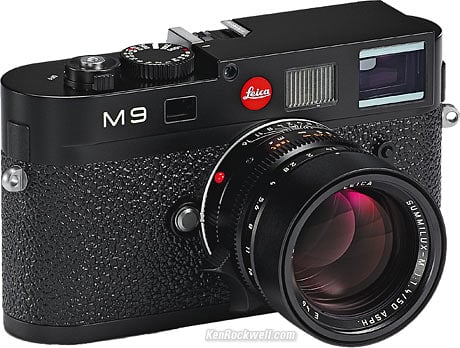
LEICA M9 and 50mm f/1.4 ASPH.
I didn't expect to be so right when I wrote The Return of the Leica last year. People really are dumping their old Nikon D3X and Canon 1Ds Mark IIIs for the LEICA M9 as fast as they can!
I know the new LEICA M9 is a much better idea than a DSLR for the serious digital landscape, travel and nature photographer, but I thought it would take longer for everyone else to figure it out.
Most people don't realize how fast a company can fall into the past when that company fails to make the right product, prices it wrong, or another company comes out with what we really wanted instead.
When smug companies think they rule the roost and can abuse their customers by overpricing the D3X (only worth $4,999 but still priced at $7,500), or hold out on introducing the D700X so they can milk us on the D3X instead, they are so screwed when another more respected company like Leica comes out with a better product for less money.
In this case, Nikon has been making their cameras and lenses bigger and heavier for no good reason each year, so when the Leica M9 comes out at about one third the weight of a pro DSLR, and for less money, Nikon just screwed themselves. The all-metal LEICA M9 weighs less than a plastic D90 for crying out loud!
My personal emancipation came last year when I upgraded to LEICA from Nikon when Nikon priced the D3X so improperly high that Leicas cost less! I was waiting for the D3X for a year, and when it came out priced abusively high, I looked around, and realized that Leica was a bargain by comparison.
Now that anyone can buy a real German Leica full-frame camera (the M9) for less than an overweight, overpriced old D3X, who would want to carry a digital Nikon anymore for travel and landscape photography? Not me!
That said, I just got a D3000 and a D300s in my hot little hands to review, but first I want to belt out an M9 lens recommendation page for all of the rest of you upgrading to Leica.
As an historical note, Leica has been making 35mm cameras and lenses since the 1920s.
Nikon never made cameras until the late 1940s, or after after World War II. Prior to and during WWII, Nikon instead specialized in making instruments for mass destruction: long-range rangefinders for artillery, military binoculars, especially large ones used on ships, and aircraft bombsights. Nikon's instruments were instrumental in Japan's terrorist attacks against America at Pearl Harbor (there was no declaration of war, and the Japanese invented suicide bombing using airplanes: kamikazes).
Nikon's warmongering divisions were disbanded after WWII, and the few guys left at Nikon sat around and wondered what to do next (ref: Rotoloni). In the late 1940s, Nikon cranked out their first rangefinder camera, intended to compete with Leica and using the same lens mount as Contax. By 1956 Nikon's best rangefinder camera was Nikon's new SP, which had some more features than the new LEICA M3, but less overall quality.
In the 1950's Nikon was second or third fiddle, behind Contax and Leica.
In 1959, Nikon leap-frogged everyone with their first SLR, the Nikon F. As we all know, the Nikon F was an incredible hit, and SLRs have pretty much put Leica out of business ever since. The Nikon F was simply the older Nikon SP rangefinder camera, with a prism welded on.
Ever since the 1960s, Leica has been playing catch-up — until last week.
Old rivalries never die, and in this case, it is all of us who benefit.
Of course SLRs are completely different kinds of cameras from rangefinders. SLRs are far smarter for close-ups, macro and ultra-tele use, while rangefinders are far better for travel, wide-angle lenses and most of what actually matters in practical photography. Polarizers and grads are easy to use with rangefinders, especially with TTL meters as Leicas have had since the 1970s. Simply preview the effect, then put the filter on your lens with the same orientation.
After I spit out the Leica Lens Recommendations, maybe I'll pen an SLR vs. Rangefinder article for those of you considering upgrading.
Missing: Nikon 55mm f/2.8 AI-s
Missing: Serial # 388555.
My first Nikon 55mm f/2.8 AI-s lens that I bought new back in 1984 is gone, and might have gotten jacked. If you see it anywhere, please let me know.
Don't get too excited: Nikon has made over a half-million of these, so unless the serial number matches exactly, it's not my missing lens.
Its not worth much, but it is the oldest Nikon lens I still had that I had bought new.
12 September 2009, Saturday
12 September 1974, 3:00 PM EDT. 3k scan.
Who's the 12-year-old kid? He's me, in my backyard on Long Island, New York!
Another amazing coincidence is that exactly 400 years ago today, Henry Hudson first sailed into and discovered what is now Manhattan, also in the afternoon. How weird a coincidence is that?
This is a self-portrait I made exactly 35 years ago today. It was a Thursday back then and I just starting 6th grade. My wife thinks I'm making this up, but here's a scan of the slide mount (you don't see the image because it's lit from a flat-bed):
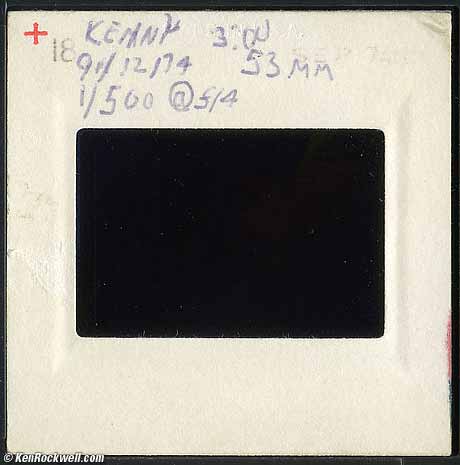
I'm a big stickler for recording data.
I put my Minolta SR-1 on a tripod. I set my shutter to 1/500 to get a large aperture, and my clip-on Minolta SR-2 meter told me to set my 53mm ROKKOR f/2 lens to f/4 for Kodachrome 25.
I have no idea how I managed to get such perfect focus.
I'm amazed that back then I knew that light and shadow were important. You can't see it, but I'm holding an 8-1/2 x 11" piece of white paper below my face to fill in the shadows.
What does this tell us? That a 12-year-old kid knows to fill in shadows with more light, not fart around with multiple HDR exposures (that would never line up because I'm alive).
It also shows the awesome power of RealRaw — just look at the sharpness in the scan of RealRaw shot 35 years ago. The actual film is even better.
More importantly, it shows how stupid I've been for decades.
That was my first camera that I had ever bought for myself. Because I considered myself an expert because I read Modern Photography and numerous other books regularly, I knew I couldn't get good pictures unless I bought better equipment.
I spent the next few decades continuously upgrading cameras and lenses, and it wasn't until the 1990s that I ever stopped worrying about more gear and finally started to make some decent photos for a change.
I was more worried about upgrading to my dream camera, a Minolta SR-T-102 I got that Christmas, than even caring about composition or anything that actually mattered for the next few decades.
Sadly, most photo hobbyists (OK, almost all photo hobbyists) I meet today worry nothing about photography, and only worry about what gear to buy. Gear doesn't matter. It's amazing how I can go off for a week, and no one talks about anything other then HDR, pano stitching, raw converters, color spaces, Canon vs. Nikon, or whatever, all of which has nothing to do with photography.
Today, I use even crummier cameras to take much better pictures. Anyone with vision and a crummy camera always aces the geeks with fancy gear and no artistic ability.
Want to take better pictures? Go take some art classes and shoot with nothing better than a Pentax K1000 35mm camera and a 50mm lens. Only if you can get good photos with that does anyone deserve any fancier camera.
Guess what: once you get to be good with a basic camera, you'll also realize you neither need nor want anything fancier. Sadly people take one basic class in photography, get sucky results, and blame their camera and not their own lack of talent for the results.
They then spend the rest of their lives chasing newer and newer gear, and often go to the grave without ever having had the epiphany at which they finally realize that it's never been about the camera.
11 September 2009, Friday
LEICA M9: Again I spent most of the morning adding to my report.
Canon SD980, 24-120mm zoom. about actual size.
NEW: Canon SD980 Review. The end of the SLR? Its super-wide zoom is fantastic!
10 September 2009, Thursday
Leica is a bargain
I'm a cheapskate. I can't afford to buy every new thing Nikon creates.
WIth Leica, they don't make their lenses obsolete every 10 to 20 years, as do other SLR makers.
With Leica, the lenses other people bought 30 years ago are still perfectly compatible with the M9. Heck, lenses made over 50 years ago are still perfectly compatible with every camera feature.
Even lenses made in the 1920s work, if you us a $60 adapter ring. Every feature and function still works — perfectly.
Buy used Leica lenses for less than new Nikon or Canon lenses, and you're good to go.
When you get a Leica lens, you're good to go for a very long time!
Many of Leica's hottest lenses have been out a long time. The state-of-the art 35mm f/1.4, the world's best 35mm f/1.4, has been around, unchanged, since 1994. If you got one when it came out, you've been state-of-the-art for 15 years, and their older ones before 1994 weren't bad either.
If you must buy only new lenses, whatever you buy will outlive you. I'm using Leica lenses today that were bought decades ago by owners who are no longer alive, and these lenses still work like new. Leica lenses are immortal.
With Leica, once you buy it, you're done and can go enjoy taking pictures for a lifetime — and then some. With the exception of Leica's digital bodies, which will suffer digital rot as much as anything else (the old M8 is already forgotten, and it only came out in 2006), what you get today you can use forever from Leica without having to "upgrade" in the future.
If you're worried about digital rot, screw the M9 and shoot RealRaw instead. You can get those Leica bodies used for less than a new D300s, and shoot them digitally anyway as I've done.
Even though every 20 years or so Leica comes out with a better version of a lens, even the old lenses are extraordinary. I still need to write up my review of their 35mm f/2 SUMMICRON which came out in 1958. It is an extraordinary lens, even today. If your dad bought one in 1958, it's still a great lens for use on today's M9 without reservation.
"The poor man always pays twice." This means that when you cheap-out and get what you don't want, or buy something from the Far East, it is designed to go obsolete in a few years, requiring you to buy it again in a newer form. You just paid twice!
Buy what you want today, and you won't have to buy something else again in the future.
In the old days, people traded in their older cameras, just like cars today, so they could get newer ones. In the old days, cameras were a lot more expensive, and people saw them as long-term investments.
We can whine about the higher initial cost of Leica, but over the long term, it's the better buy. If you buy used as I do, it's a totally free ride.
Anyone can get an M3 or M4-P for half the price of a 5D Mk II, and two years from now, the LEICA is still worth what was paid for it, while the 5D Mark II is sold as scrap.
LEICA M9: I rewrote everything in my report yesterday afternoon. My dealer claims mine ought to be here next week, then things will really hit the fan, hee hee!
Sure' I'll compare ISOs and sharpnesses, but the real difference is in how lucidly it works and how much crap you have to carry around.
With a 5D Mark II or D700, you're carrying 30oz (850g) for the Canon or 36 oz (1kg) for the Nikon body, and about 25 oz (700g) for just one typical zoom, of which you'll bring two.
With the M9, you only have a 20 oz (590g) body, and your wide lens weighs maybe 11 oz (320g for the 21mm) or 6 oz (173g for a 28mm) lens, and so fourth.
For the M9, a minimum weight, full-performance professional travel kit is the M9, Voigtländer 21mm M, 50mm f/2 SUMMICRON, and 90mm f/2.8 TELE-ELMARIT.
Total system weight for the LEICA M9? 585g + 132g + 240g + 225g, or 1,182g or 42 oz. This entire pro M9 system weighs less than a D3X, which weighs 43 oz (1,200g) with no lens and no battery!
So why would I want a D3X, which costs more than an M9, for travel and the sorts of outdoor photography I do where I have to schlep this all with me everywhere?
I buy my Leica lenses used from years ago, so they cost me less than the hot new Nikon and Canon zooms.
New iPod Touch: The world's best mobile computer, the iPod Touch, just stayed the same. There is no camera built in, which is odd since the otherwise identical iPhone and the new iPod Nano have cameras.
As soon as a better iPod Touch comes out I'm buying one since they are so inexpensive and since I use it all day, every day, but since the new iPod Touch model introduced yesterday isn't anything different from what I can see from what I have, I'll forget about it.
09 September 2009, Wednesday 9/9/09
LEICA M9 with 50mm f/1.4 ASPH.
NEW: LEICA M9.
The LEICA M9 is the smallest, lightest, highest-quality digital camera ever created by the hand of Man, and it's less expensive than the Nikon D3X. Need I say any more?
The LEICA M9 is the most important digital camera ever created for the creative travel, nature and landscape photographer.
The M9 offers the highest quality obtainable in digital capture due to its superior optics, and when one considers that it is smaller and lighter than any other full-frame digital camera, the choice is obvious for those who deserve the best.
LEICA X1.
NEW: LEICA X1. A $2,000 German fixed-lens point-and-shoot.
08 September 2009, Tuesday
Canon SD880 Firmware: Canon fixed a tiny glitch.
Nikon D300s: I should be getting my hands on one for serious review later today, and Adorama now has them in stock.
DEAL: Adorama has refurbished D2Hs for $1,200 each. For sports, these are pro-level cameras probably better than today's amateur D300s.
DEAL: Adorama is telling me that these Altec Lansing UHP606 in-ear soft headphones are a screaming deal at $39, since they usually sell for over $50.
Check out these crisp black-and-white photos by a stranger.
They were shot in 1941 on RealRaw. Note the superior tonality and detail.
07 September 2009, Monday
Olympus E-P and 17mm f/2.8.
NEW: Olympus E-P1 Review. It really does give the same technical image quality as a DSLR, but its handling is only as fast as a pocket camera. It will be a while until Olympus introduces a complete line of tiny lenses to do it justice.
I work for myself, so I never get holidays. My loss, your gain.
04 September 2009, Friday
First Day of School!
OK, Ryan's first day of preschool was actually two days ago when I was out shooting in Point Reyes, but today was his second day, and my first day to see him.
What did I bring to shoot it? My D40, 18-200mm and SB-400 with a 1/2 CTO gel taped over it, of course.
As always, the results from the D40 always impress me. That's why I grab it first for important occasions.
Also note that I had all these photos on-the-air only a few minutes after I got home so I could get on to more important things. If I had goofed ad shot raw, my files would still be downloading, much less all processed, cataloged and live a few minutes later.
03 September 2009, Thursday
I'm back!
Point Reyes, yesterday morning. bigger. Shot with Canon SD980.
I'm back from Point Reyes, and may even have gotten a couple of good shots. As I unpack, I'll let you know.
I shot with the brand-new Canon SD980 pocket camera, with its 24-120mm equivalent lens, and the results are looking spectacular here as I transfer them this morning.
Abbott Lagoon, Tuesday evening. bigger. Shot with Canon SD980.
Both of these shots are direct from the camera; I just downloaded from my card on my return. The colors and results are looking great!
Olympus E-P1
I also had my Olympus E-P1 appear, so I'll let you know about that as I play with it.
The Olympus E-P1 and the 17mm lens are both made in China, like everything good. The bottom of the body is clearly marked, under an apology about being "designed in Japan," and the lens hides "Made in China" by engraving it in black-on-black on the back of the lens mount where no one will ever find it.
Geesh, if camera makers are ashamed about where they make things, why not just make them someplace else? My Apple iPod Touch, the world's most advanced consumer electronics product and the only computer I needed this past week, is made in China, too. The Japanese and Americans simply can't make competitive consumer products with the precision of the Chinese. (Of course American industrial and military products are another story.)
Is it D700X yet?
The latest boloney claims NASA as being a driving force behind the design of the D700X.
NASA?
Do you mean the same NASA that was so screwed by Nikon that it was sold seventy-six D2Xs cameras the day before it went obsolete and the far superior next-generation D3 and D300 were announced? NASA and Nikon announced the D2Xs purchase on 22 August 2007, and then Nikon thought it was safe to announce the D3 and D300 the next day, 23 August 2007. (see the D3 press release and D300 press release if you think I'm kidding.)
NASA is not the driver behind the D700X. Nikon obviously doesn't consider NASA as a trusted partner.
If anything, I doubt NASA would ever buy Nikon again after being hoodwinked like that. Nikon stuck NASA with old stock! It was like Pearl Harbor all over again.
What Was New in:
The end of September, 2008 (Photokina)
The beginning of September, 2008
December 2007: Loads of details about the Nikon D3, D300, 14-24mm and 24-70mm, much of which still isn't on the individual review pages.
November 2007: First hands-on details about the Nikon D3, D300, 14-24mm and 24-70mm, much of which still isn't on the individual review pages.
August 2007 (Loads of new Nikons and Canons)
2006 November - December (includes birth of Ryan Rockwell)
2006 October - November (includes photos from a trip to NY)
Help me help you top
I support my growing family through this website, as crazy as it might seem.
If you find this as helpful as a book you might have had to buy or a workshop you may have had to take, feel free to help me continue helping everyone.
If you've gotten your gear through one of my links or helped otherwise, you're family. It's great people like you who allow me to keep adding to this site full-time. Thanks!
If you haven't helped yet, please do, and consider helping me with a gift of $5.00.
The biggest help is when you use any of these links when you get anything. It costs you nothing, and is this site's, and thus my family's, biggest source of support. These places always have the best prices and service, which is why I've used them since before this website existed. I recommend them all personally.
Thanks for reading!
Ken
Home Donate New Search Gallery How-To Books Links Workshops About Contact




